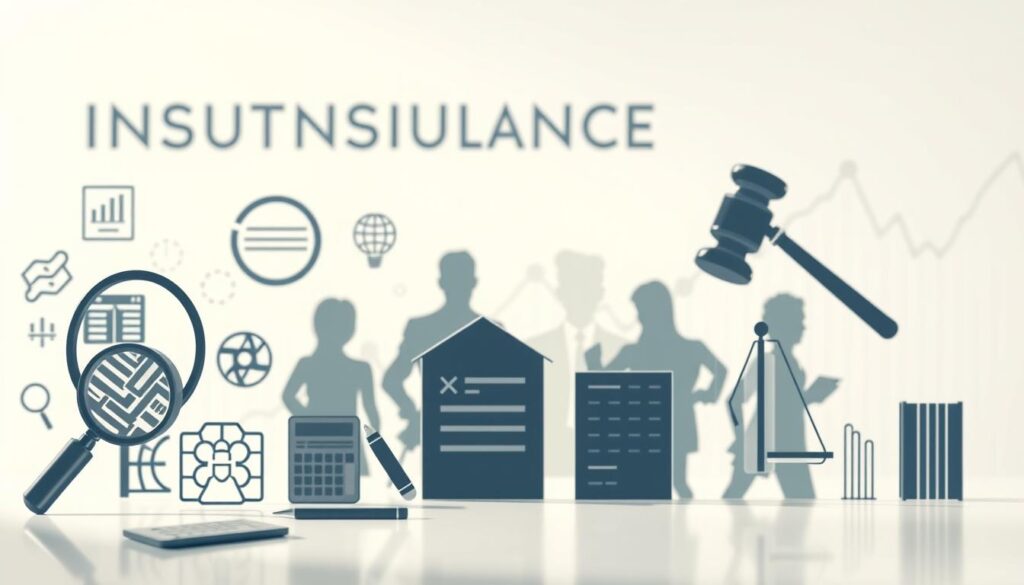Navigating the complex landscape of insurance in the United States can be daunting. With various options, regulations, and best practices to consider, understanding the system is crucial for making informed decisions.
This comprehensive guide aims to simplify the process by providing an in-depth exploration of the US insurance system. Readers can expect to gain a thorough understanding of the different types of insurance available, the regulatory framework governing the industry, and practical tips for choosing the right coverage.
Key Takeaways
- Understanding the basics of the US insurance system
- Exploring different types of insurance available
- Learning about the regulatory framework
- Discovering best practices for selecting insurance coverage
- Navigating the complexities of insurance in the United States
Understanding the US Insurance Landscape
Understanding the history and current state of insurance in the US is crucial for consumers. The insurance industry plays a vital role in the American economy, providing financial protection to individuals and businesses against various risks.
The Evolution of Insurance in America
The history of insurance in the United States dates back to the 18th century. Insurance has evolved significantly from simple mutual aid societies to complex, multi-billion-dollar industries. Over time, insurance products have become more sophisticated, catering to diverse needs such as health, auto, home, and life insurance.
Key Players in the US Insurance Market
The US insurance market is dominated by several large players, including State Farm, Allstate, and Liberty Mutual. These companies offer a range of insurance products, from auto and home insurance to life and health insurance. Their presence shapes the market and influences insurance trends.
Regulatory Framework and Oversight
The insurance industry in the US is regulated at the state level. State insurance departments oversee the industry, ensuring compliance with regulations and protecting consumer interests. This regulatory framework is crucial for maintaining fair practices and stability in the insurance market.
In conclusion, the US insurance landscape is shaped by its history, major insurance companies, and regulatory bodies. Understanding these elements is essential for navigating the complex world of insurance.
Types of Insurance in the United States
Understanding the different types of insurance available is crucial for making informed decisions. The US insurance market is diverse, offering various insurance products that cater to different aspects of life and business.
Health Insurance Options
Health insurance is one of the most critical types of insurance, providing financial protection against medical expenses. It comes in various forms, each designed to meet different needs.
Individual Plans vs. Group Coverage
Individual plans are purchased directly by consumers from insurance companies or through the health insurance marketplace. These plans are ideal for self-employed individuals, freelancers, or those not covered by employer-sponsored plans.
Group coverage, on the other hand, is typically offered by employers to their employees. Group plans often have more favorable terms and lower premiums due to the risk being spread across a larger group of people.
Supplemental Health Insurance
Supplemental health insurance provides additional coverage for specific medical needs not fully covered by primary health insurance. This can include critical illness insurance, accident insurance, or hospital indemnity insurance.
Auto Insurance Requirements
Auto insurance is mandatory in most states, with requirements varying significantly. Drivers must comply with their state’s minimum coverage requirements, which typically include liability insurance to cover damages to others in the event of an accident.
Homeowners and Renters Insurance
Homeowners insurance protects against losses to one’s home and its contents. It typically covers damages from natural disasters, theft, and vandalism.
Renters insurance, while not mandatory, is highly recommended for tenants. It covers personal belongings against theft, damage, or loss, and can also provide liability coverage.
Life Insurance Varieties
Life insurance provides financial security for dependents in the event of the policyholder’s death. The primary types include term life insurance, which covers a specific period, and whole life insurance, which covers the policyholder’s lifetime and includes a cash value component.
Disability and Long-Term Care Insurance
Disability insurance replaces income if the policyholder becomes unable to work due to illness or injury. Long-term care insurance covers the cost of long-term care services, such as nursing home care, assisted living, or home care, which are not typically covered by health insurance.
Health Insurance: Navigating the Complexities
Health insurance is a critical component of financial planning in the US, yet its intricacies often leave consumers perplexed. With various options available, understanding the nuances of health insurance is essential for making informed decisions.
Understanding the Affordable Care Act
The Affordable Care Act (ACA), also known as Obamacare, has significantly impacted the health insurance landscape. It introduced key reforms such as prohibiting insurers from denying coverage based on pre-existing conditions and allowing young adults to stay on parental insurance until age 26.
Key Provisions of the ACA:
- Expansion of Medicaid eligibility
- Creation of Health Insurance Marketplaces
- Requirement for essential health benefits
Employer-Sponsored Health Plans
Many Americans receive health insurance through their employers. These plans can vary widely in terms of coverage and cost.
HMOs vs. PPOs vs. HDHPs
Employer-sponsored plans often come in different forms, including HMOs (Health Maintenance Organizations), PPOs (Preferred Provider Organizations), and HDHPs (High-Deductible Health Plans). Each has its advantages and disadvantages.
| Plan Type | Network Flexibility | Premiums | Deductible |
|---|---|---|---|
| HMO | Limited to network | Generally lower | Lower |
| PPO | More flexible, out-of-network coverage | Higher | Higher |
| HDHP | Varies | Lower | Higher |
Using FSAs and HSAs Effectively
Flexible Spending Accounts (FSAs) and Health Savings Accounts (HSAs) are tools that can help manage healthcare costs. FSAs allow pre-tax dollars for medical expenses, while HSAs are available with HDHPs and offer more flexibility.
Medicare and Medicaid Explained
Medicare and Medicaid are government programs that provide health coverage to specific populations. Medicare is generally for those 65 and older, while Medicaid is for low-income individuals and families.
Understanding the eligibility and benefits of these programs is crucial for those who qualify.
Individual Market Plans and Exchanges
For those not covered by employer plans or government programs, individual market plans and exchanges offer alternatives. These plans can be purchased directly from insurers or through state or federal exchanges.
Comparing different plans and understanding the enrollment periods is vital for securing appropriate coverage.
Auto Insurance: Beyond the Basics
Understanding auto insurance is essential for protecting yourself and others on the road. Auto insurance is not just a legal requirement in most states, but it also provides financial protection against various risks associated with driving.
Minimum Coverage Requirements by State
Each state has its own minimum auto insurance requirements. For instance, some states require drivers to have liability coverage that includes bodily injury and property damage, while others may have additional requirements such as personal injury protection (PIP) or uninsured motorist coverage. It’s crucial to familiarize yourself with your state’s specific requirements to ensure compliance.
Understanding Liability, Collision, and Comprehensive Coverage
Liability coverage is fundamental, covering damages to others in an accident. Collision coverage pays for damages to your vehicle, regardless of fault, while comprehensive coverage protects against non-collision incidents like theft or natural disasters. Understanding these coverage types is vital for making informed decisions about your auto insurance.
Additional Coverages Worth Considering
Beyond the basics, there are several additional coverages that can enhance your protection. These include:
- Gap Insurance for new vehicles, which covers the difference between the vehicle’s actual cash value and the outstanding loan or lease balance if the vehicle is totaled.
Gap Insurance for New Vehicles
- Gap insurance is particularly valuable for new car owners who may owe more on their loan than the car is worth.
- Roadside Assistance and Rental Reimbursement, which can provide help in case of a breakdown or when your vehicle is being repaired.
Roadside Assistance and Rental Reimbursement
- These services can be lifesavers during stressful situations, offering towing, fuel delivery, and rental car coverage.
Factors Affecting Your Auto Insurance Rates
Several factors can influence your auto insurance rates, including your driving history, age, location, vehicle type, and credit score. Maintaining a clean driving record, choosing a vehicle with a good safety record, and improving your credit score can help lower your premiums.
Protecting Your Home: Property Insurance Essentials
Homeownership comes with various risks, and understanding property insurance is key to mitigating these risks. Property insurance is designed to protect your home and financial well-being from unforeseen events such as natural disasters, theft, and accidents.
Homeowners Insurance Components
Homeowners insurance is a comprehensive policy that covers various aspects of homeownership. It includes:
- Dwelling Coverage: Protects the physical structure of your home against damages.
- Personal Property: Covers your personal belongings against theft or damage.
Dwelling Coverage vs. Personal Property
Understanding the difference between dwelling coverage and personal property coverage is crucial. Dwelling coverage focuses on the home’s structure, while personal property coverage protects your belongings.
Liability Protection for Homeowners
Liability protection is another critical component, shielding you from financial losses if someone is injured on your property. It can cover legal fees and medical expenses.
Renters Insurance: Why It’s Crucial
Renters insurance is often overlooked but is vital for protecting your personal belongings against theft, fire, and other damages. It also provides liability coverage.
Flood and Earthquake Insurance Considerations
Standard homeowners insurance typically does not cover floods and earthquakes. Separate policies or endorsements are often required for these risks, especially in prone areas.
Condo and Co-op Insurance Specifics
Condo and co-op insurance differ from traditional homeowners insurance due to the shared ownership structure. These policies typically cover the interior of the unit and personal property.
In conclusion, property insurance is a vital aspect of protecting your home and financial stability. Understanding the various components and types of insurance available can help you make informed decisions.
Life Insurance: Securing Your Family’s Future
Life insurance is a crucial component of a comprehensive financial plan, providing security for your loved ones in the event of your passing. It ensures that your dependents are financially protected and can maintain their standard of living even if you’re no longer around to provide for them.
Term vs. Whole Life Insurance
When considering life insurance, one of the primary decisions is between term and whole life insurance. Term life insurance provides coverage for a specified period (e.g., 10, 20, or 30 years), paying a death benefit if you pass away during the term. On the other hand, whole life insurance covers you for your entire life, as long as premiums are paid, and includes a cash value component that grows over time.
Determining How Much Coverage You Need
Determining the right amount of life insurance coverage depends on several factors, including your income, expenses, debts, and future financial goals. A common rule of thumb is to have coverage that is 5-10 times your annual income. However, a more detailed assessment may be necessary to ensure you’re adequately covered.
Beneficiary Designations and Policy Management
It’s essential to carefully consider your beneficiary designations and keep your policy up to date. Ensure that your beneficiaries are aware of the policy details and know how to file a claim if necessary.
Life Insurance for Different Life Stages
Life insurance needs can vary significantly at different stages of life. For young families, the focus is often on ensuring that dependents are protected in case of a parent’s passing. For those nearing retirement, the focus may shift to using life insurance as part of their estate planning or to cover final expenses.
Young Families vs. Pre-Retirement Planning
Young families typically require more extensive coverage to protect their dependents, while those nearing retirement may need to adjust their coverage levels based on their changing financial circumstances.
Business Succession Planning
For business owners, life insurance can play a critical role in succession planning, providing funds to buy out a deceased partner’s share or to cover business debts.
Specialized Insurance Policies
Specialized insurance policies provide coverage for niche areas, ensuring comprehensive protection for individuals and businesses alike. These policies cater to specific needs that aren’t addressed by standard insurance types.
Business Insurance Essentials
Business insurance is crucial for protecting companies against various risks, including liability, property damage, and employee injuries. It helps businesses recover from unforeseen events and maintain operations.
Travel Insurance Benefits
Travel insurance offers protection against trip cancellations, medical emergencies, and lost luggage. It’s essential for frequent travelers or those embarking on expensive or adventurous trips.
Pet Insurance Considerations
Pet insurance helps cover veterinary costs for accidents or illnesses, ensuring pet owners can provide necessary care without financial strain.
Umbrella Policies for Extra Protection
Umbrella policies provide additional liability coverage beyond standard policy limits, protecting assets from potential lawsuits and financial ruin.
How to Assess Your Insurance Needs
Evaluating your insurance needs is a personal and ongoing process that requires careful consideration. As life events unfold and circumstances change, it’s essential to regularly assess your insurance coverage to ensure it remains aligned with your needs.
Conducting a Personal Risk Assessment
A thorough risk assessment is the foundation of determining your insurance needs. This involves identifying potential risks and evaluating their impact on your financial well-being.
Identifying Your Valuable Assets
Start by making a list of your valuable assets, including your home, vehicles, savings, and other significant possessions. Consider the potential cost of replacing or repairing these assets in the event of loss or damage.
Evaluating Potential Liabilities
Assess your potential liabilities, such as outstanding debts, dependents, and potential legal obligations. This will help you understand the level of coverage you need to protect your financial stability.
Life Events That Trigger Insurance Reviews
Certain life events, such as marriage, having children, or changing jobs, can significantly impact your insurance needs. It’s crucial to review and adjust your insurance coverage during these times.
Balancing Coverage and Cost
Finding the right balance between coverage and cost is essential. While it’s tempting to opt for the cheapest option, ensure you’re not sacrificing necessary coverage.
Working with Financial Advisors
Consider consulting with financial advisors to get personalized advice on assessing your insurance needs. They can provide valuable insights and help you make informed decisions.
By following these steps and regularly reviewing your insurance coverage, you can ensure that you’re adequately protected against life’s uncertainties.
Shopping for Insurance: Best Practices
When it comes to shopping for insurance in the United States, understanding the best practices can make a significant difference in your overall experience and financial security. The process involves several key steps that help you navigate the complex insurance landscape effectively.
Researching Insurance Companies
Before purchasing an insurance policy, it’s crucial to research the insurance company thoroughly. This involves evaluating their financial strength and customer satisfaction metrics.
Financial Strength Ratings
Financial strength ratings are a critical indicator of an insurance company’s ability to pay claims. Agencies like A.M. Best, Moody’s, and Standard & Poor’s provide these ratings. Look for companies with high ratings (A or above) to ensure they can meet their financial obligations.
Customer Satisfaction Metrics
Customer satisfaction is another vital factor. Check consumer reports and reviews to gauge how well an insurance company serves its policyholders. High customer satisfaction often correlates with better service and claims handling.
Getting and Comparing Quotes Effectively
Obtaining and comparing quotes from multiple insurance providers is essential. This process helps you identify the best coverage at the most competitive price. Use online comparison tools or work with an independent insurance agent to streamline this process.
| Insurance Company | Premium Cost | Coverage Limit | Deductible |
|---|---|---|---|
| Company A | $800 | $100,000 | $500 |
| Company B | $850 | $150,000 | $250 |
| Company C | $750 | $100,000 | $750 |
Understanding Policy Language and Fine Print
It’s vital to read and understand the policy language and fine print. This includes knowing what is covered, what is excluded, and the terms of the policy. Don’t hesitate to ask questions if you’re unsure about any aspect of the policy.
Negotiating Better Rates and Terms
Negotiating with insurance companies can sometimes yield better rates or more favorable terms. Ask about discounts or special programs that you might be eligible for. Bundling policies or improving your risk profile can also lead to lower premiums.

Maximizing Insurance Discounts and Savings
Policyholders can substantially lower their insurance expenses by exploring and utilizing the various discounts and savings available in the US. Insurance companies offer a range of discounts that can significantly reduce premiums when policyholders take advantage of them.
Multi-Policy Bundling Strategies
Bundling multiple insurance policies with the same provider can lead to substantial discounts. For instance, combining auto and home insurance can result in a multi-policy discount. Insurance companies often reward customer loyalty with lower rates for bundled services.
Loyalty and Good Customer Discounts
Many insurance companies offer loyalty discounts to long-term customers. Maintaining a good relationship with your insurer and being a responsible customer can lead to lower premiums over time.
Improving Factors That Affect Your Rates
Several factors influence insurance rates, and improving these can lead to savings. Two key areas to focus on are credit score optimization and implementing safety features.
Credit Score Optimization
Maintaining a good credit score is crucial as insurers often use credit-based insurance scores to determine premiums. A higher credit score can lead to lower insurance rates.
Safety Features and Preventive Measures
Installing safety features in your home or vehicle can reduce the risk of claims, thereby lowering your insurance premiums. Examples include home security systems and anti-theft devices in cars.
| Safety Feature | Potential Savings |
|---|---|
| Home Security System | Up to 20% on Home Insurance |
| Anti-theft Device in Car | Up to 15% on Auto Insurance |
Tax Benefits of Certain Insurance Policies
Some insurance policies offer tax benefits. For example, life insurance policies can provide tax-free benefits to beneficiaries. Understanding these benefits can help in maximizing overall savings.
Filing Claims: Step-by-Step Process
Filing an insurance claim can be a daunting task, but understanding the process can make it more manageable. Insurance claims are a critical aspect of the insurance industry in the United States, providing policyholders with financial protection against unforeseen events.
Documenting Incidents Properly
The first step in filing a successful insurance claim is to document the incident thoroughly. This involves gathering evidence such as photographs, witness statements, and any relevant documentation like police reports or medical records. Proper documentation is crucial as it helps to establish the facts of the incident and supports the claim.
Contacting Your Insurance Company
Once the incident is documented, the next step is to contact your insurance company to notify them of the claim. This can usually be done by phone or through the company’s website. It’s essential to have your policy number and details of the incident ready to facilitate the process.
Working with Claims Adjusters
After notifying the insurance company, a claims adjuster will be assigned to your case. The adjuster’s role is to investigate the claim and determine the extent of the damage or loss. Being prepared for this step can make a significant difference in the outcome.
Preparing for Adjuster Visits
To prepare for the adjuster’s visit, ensure that you have all relevant documentation available. This may include receipts for repairs, medical bills, or other expenses related to the claim. Being organized can help to expedite the process.
Negotiating Claim Settlements
In some cases, the initial settlement offer may not be satisfactory. Understanding your policy and the terms of your coverage can empower you to negotiate a more favorable settlement. It’s also helpful to keep detailed records of all correspondence with the insurance company.
Appealing Denied Claims
If your claim is denied, you have the right to appeal the decision. This typically involves providing additional information or context that may have been overlooked during the initial assessment. Persistence and patience are key when navigating the appeals process.
Understanding Insurance Terminology
Deciphering insurance terminology is a vital step in ensuring you have the right coverage for your needs. The insurance industry uses specific language that can be confusing for those not familiar with it.
Decoding Policy Language
Insurance policies are legal contracts filled with terminology that can be daunting. Policy language is often complex, making it essential to understand the key terms and conditions.
For instance, the declarations page is a crucial part of your insurance policy, summarizing the key details of your coverage, including the insured’s name, policy period, coverage limits, and premiums.
Premium, Deductible, and Coinsurance Explained
Understanding the financial aspects of your insurance policy is vital. Three key components are premium, deductible, and coinsurance.
| Term | Definition | Example |
|---|---|---|
| Premium | The amount paid for insurance coverage | $500 annual premium for auto insurance |
| Deductible | The amount paid out-of-pocket before insurance kicks in | $1,000 deductible for health insurance |
| Coinsurance | The percentage of costs shared with the insurer after deductible | 20% coinsurance for medical bills |
Exclusions and Limitations to Watch For
Every insurance policy has exclusions and limitations, which define what is not covered or the maximum amount the insurer will pay.
Understanding these elements is crucial to avoid surprises when filing a claim. For example, a homeowner’s policy might exclude flood damage, requiring a separate flood insurance policy.
Endorsements and Riders
Endorsements and riders are amendments to your insurance policy that can add or modify coverage. They allow you to customize your policy to better suit your needs.
For instance, adding a rider to a life insurance policy can provide additional benefits, such as accelerated death benefits in case of terminal illness.

Common Insurance Mistakes to Avoid
The US insurance landscape is complex, and avoiding common mistakes is key to securing your financial future. Insurance mistakes can have significant financial implications, making it crucial to understand common pitfalls.
Underinsuring Your Assets
One of the most significant insurance mistakes is underinsuring your assets. This can leave you financially vulnerable in the event of a loss. For example, if you have a homeowner’s insurance policy that doesn’t cover the full value of your home, you may be left with significant out-of-pocket expenses if you need to rebuild or repair your home after a disaster.
Overlooking Policy Details
Overlooking policy details is another common insurance mistake. It’s essential to carefully review your insurance policies to understand what is covered and what is not. Pay particular attention to exclusions and limitations, as these can significantly impact your coverage.
Failing to Update Coverage After Life Changes
Failing to update your coverage after significant life changes is a common mistake that can leave you underinsured or overinsured. Life events such as marriage, having children, or changing jobs can impact your insurance needs. Regularly reviewing and updating your coverage can help ensure that you have the right amount of insurance.
Choosing Price Over Coverage Quality
Choosing price over coverage quality is a mistake that can have significant financial implications. While it’s essential to find an insurance policy that fits your budget, it’s equally important to consider the quality of coverage. A cheap policy with inadequate coverage can leave you financially vulnerable.
| Common Insurance Mistakes | Consequences | Prevention Strategies |
|---|---|---|
| Underinsuring Your Assets | Financial vulnerability in the event of a loss | Regularly review and update your coverage |
| Overlooking Policy Details | Inadequate coverage or denied claims | Carefully review policy details, including exclusions and limitations |
| Failing to Update Coverage After Life Changes | Underinsured or overinsured | Regularly review and update your coverage after significant life events |
| Choosing Price Over Coverage Quality | Inadequate coverage or financial vulnerability | Consider both price and coverage quality when selecting an insurance policy |
The Future of Insurance in America
The future of insurance in America is being shaped by technological advancements and shifting consumer needs. As the industry evolves, several key trends are emerging that will define the insurance landscape in the years to come.
Technology and Digital Transformation
The insurance industry is undergoing a significant digital transformation. Artificial intelligence and machine learning are being leveraged to improve underwriting, claims processing, and customer service. Insurtech companies are also playing a crucial role in driving innovation.
Emerging Coverage Types
New and emerging coverage types are being developed to address evolving consumer needs. For example, cyber insurance is becoming increasingly important as technology advances. Other emerging areas include insurance products for autonomous vehicles and climate-related risks.
Changing Regulatory Landscape
The regulatory environment is also evolving, with a focus on consumer protection and innovation. Insurers must stay abreast of changing regulations and adapt their business models accordingly.
Consumer-Driven Insurance Trends
Consumers are driving demand for more personalized and flexible insurance products. Insurers are responding by offering usage-based insurance and other tailored solutions.
- Increased use of technology in insurance processes
- Emergence of new coverage types
- Evolving regulatory landscape
- Consumer-driven trends shaping insurance products
Conclusion: Creating Your Personal Insurance Strategy
Developing a comprehensive insurance strategy is crucial for protecting your financial well-being in the United States. By understanding the various types of insurance available, including health, auto, home, and life insurance, you can make informed decisions about your coverage needs.
To create an effective insurance strategy, start by assessing your personal risk factors and financial situation. Consider factors such as your income, expenses, assets, and dependents when determining the right level of coverage for you.
Insurance in the United States is a complex and multifaceted industry, but by being proactive and informed, you can navigate the system with confidence. Regularly reviewing and updating your insurance coverage will help ensure that you remain adequately protected against life’s uncertainties.
By following the guidelines outlined in this article and staying informed about insurance in the United States, you can develop a personalized insurance strategy that meets your unique needs and provides peace of mind for you and your loved ones.
FAQ
What is the purpose of insurance in the United States?
The primary purpose of insurance in the United States is to provide financial protection against unforeseen events, such as accidents, natural disasters, or health issues, by pooling risks and offering coverage to individuals and businesses.
How does the Affordable Care Act affect health insurance?
The Affordable Care Act (ACA) has significantly impacted health insurance in the US by expanding coverage to more individuals, prohibiting insurance companies from denying coverage based on pre-existing conditions, and allowing young adults to stay on parental insurance until age 26.
What are the minimum auto insurance requirements in the US?
Minimum auto insurance requirements vary by state, but most states require liability coverage, which includes bodily injury and property damage coverage, with specific minimum limits that differ from state to state.
What is the difference between term and whole life insurance?
Term life insurance provides coverage for a specified period (e.g., 10, 20, or 30 years), while whole life insurance offers lifetime coverage with a cash value component that accumulates over time.
How can I lower my insurance premiums?
To lower insurance premiums, consider bundling policies, improving your credit score, installing safety features, and taking advantage of discounts offered by insurance companies, such as good student or defensive driving discounts.
What is an umbrella insurance policy?
An umbrella insurance policy provides additional liability coverage beyond the limits of your standard insurance policies (e.g., auto, homeowners), protecting your assets from potential lawsuits and financial losses.
How do I file an insurance claim?
To file an insurance claim, document the incident thoroughly, notify your insurance company promptly, and cooperate with claims adjusters to assess the damage and determine the settlement.
What is the role of insurance regulators in the US?
Insurance regulators in the US oversee the insurance industry, ensuring compliance with state laws and regulations, monitoring financial solvency, and protecting consumer interests.
Can I purchase insurance from out-of-state companies?
While it is possible to purchase insurance from out-of-state companies, it is crucial to verify that the insurer is licensed to operate in your state and complies with local regulations.
How often should I review my insurance coverage?
It is recommended to review your insurance coverage annually or whenever significant life changes occur, such as marriage, having children, or purchasing a new home, to ensure your coverage remains adequate and relevant.



